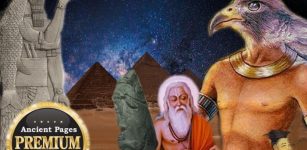Rock Stars: How A Group Of Scientists In South Africa Rescued A Rare 500 Kg Chunk Of Human History
AncientPages.com - Scientific breakthroughs can happen in the strangest ways and places. Alexander Fleming discovered penicillin because of mold growing on a Petri dish left out while he was on holiday. Chinese monks in the 9th century wanted to make a potion for immortality: instead, they discovered gunpowder.
Our own remarkable discovery happened on a rugged, remote stretch of coastline east of Still Bay on South Africa's Cape south coast. It was low tide, and three members of our ichnology team (people who study tracks and traces) were in search of newly exposed Pleistocene vertebrate tracksites in aeolianites (cemented dunes).
The larger of the two triangular geometric features (scale bar = 10 cm). Credit: Charles Helm
Ahead we saw a large rock that had tumbled down from the cliffs above. On its surface was a pattern of linear groove features in a large triangular shape, complete with an almost perfect bisecting groove. The sides of the triangle were close to a meter in length. After extensive research, we concluded that these grooves must have been made on a dune surface of unconsolidated sand by our human ancestors in the Middle Stone Age. The patterns are likely between 143,000 and 91,000 years old.
It was an important find in a significant place. Multiple lines of evidence on this coastline indicate that it's an area where our distant ancestors became truly modern, using fire as an engineering tool and creating abstract images.
But there was a problem. On a followup visit we found a smaller rock close by with a similar triangular feature. Subsequently, it was destroyed, likely by storm surges or high tides buffeting and overturning it. We knew that the larger rock inevitably awaited a similar fate if we did nothing. From our perspective this is one of the most important rocks in the world: it takes us back to our roots as a species and indicates the kind of "proto-art" we were capable of creating so long ago.
An unusual ‘rescue operation’ captured on video by Richard Webb.
The rock has subsequently been encased and placed on exhibit, with interpretive text panels. It joins similar exhibits in the museum; the grooves were an example of an ammoglyph, a term we had coined to describe a pattern created by humans in sand that is now evident in rock that has become cemented and then re-exposed.
Ascribing meaning to these geometric patterns made so long ago by our distant ancestors is not within our field of expertise. Still, we could not help but notice the resemblance of the triangular shape to a purported fertility symbol found in France and dated to around 38,000 years. Should the pattern on our rock represent the same motif, it would not be the first time that southern African discoveries had pushed back in time what has been viewed as an Upper Paleolithic Eurasian phenomenon.
A helicopter, net and a long-line cable - as well as a skilled pilot - were key to the ‘rescue’ operation. Credit: Richard Webb
Our research team now sleeps better at night, knowing that this priceless piece of our human heritage has been recovered and is available for others to see, appreciate and critique.
More to discover
Happily, there was an unexpected bonus. Beside the eroded remains of the second rock our ground crew noted a third rock surface which had not been evident previously. Near one edge it contained a distinct pair of grooves that met at an angle of 69 degrees, forming what may have been part of another triangular feature.
This is clearly an area we will return to repeatedly, in the hope that tidal forces may turn over other rocks before destroying them, and may give us an opportunity to glimpse—and perhaps recover—more ammoglyphs.
Written by Charles Helm, Research Associate, African Centre for Coastal Palaeoscience, Nelson Mandela University
and Jan Carlo De Vynck, Director and research fellow, African Centre for Coastal Palaeoscience, Nelson Mandela University, Nelson Mandela University
This article is republished from The Conversation under a Creative Commons license. Read the original article.
More From Ancient Pages
-
 This Is One Of The Oldest Pieces Of Cloth In The World And It’s Made Of Bast Fibers!
Featured Stories | Aug 26, 2023
This Is One Of The Oldest Pieces Of Cloth In The World And It’s Made Of Bast Fibers!
Featured Stories | Aug 26, 2023 -
 Apollo – Loved And Feared Greek God Of Divination And Prophecy Who Was Also Seer Of Zeus
Featured Stories | Feb 6, 2019
Apollo – Loved And Feared Greek God Of Divination And Prophecy Who Was Also Seer Of Zeus
Featured Stories | Feb 6, 2019 -
 Jörmungandr – Hideous Poison-Spewing Midgard Serpent Was One Of Loki’s Children
Featured Stories | Mar 31, 2018
Jörmungandr – Hideous Poison-Spewing Midgard Serpent Was One Of Loki’s Children
Featured Stories | Mar 31, 2018 -
 Study Traces DNA Of Inca Emperors To Their Modern-Day Descendants
Archaeology | May 29, 2018
Study Traces DNA Of Inca Emperors To Their Modern-Day Descendants
Archaeology | May 29, 2018 -
 Extremely Brutal Conflicts Among Maya Broke Out Before Civilization’s Decline
Archaeology | Aug 8, 2019
Extremely Brutal Conflicts Among Maya Broke Out Before Civilization’s Decline
Archaeology | Aug 8, 2019 -
 Never-Before-Seen Colorful Inscriptions And Reliefs At The Esna Temple, Egypt Revealed After Restoration
Archaeology | May 16, 2022
Never-Before-Seen Colorful Inscriptions And Reliefs At The Esna Temple, Egypt Revealed After Restoration
Archaeology | May 16, 2022 -
 Ancient Roman Shipwreck Marausa 2 With Intact Cargo Recovered Off The Coast Of Sicily
Archaeology | Oct 23, 2023
Ancient Roman Shipwreck Marausa 2 With Intact Cargo Recovered Off The Coast Of Sicily
Archaeology | Oct 23, 2023 -
 Lindholm Høje Burial Site With 700 Graves Dated To The Iron And Viking Ages
Featured Stories | Nov 17, 2016
Lindholm Høje Burial Site With 700 Graves Dated To The Iron And Viking Ages
Featured Stories | Nov 17, 2016 -
 Has The Mysterious Ancient Underground Labyrinth Of Mitla Finally Been Found?
Archaeology | Aug 14, 2023
Has The Mysterious Ancient Underground Labyrinth Of Mitla Finally Been Found?
Archaeology | Aug 14, 2023 -
 Scottish Settler’s Ominous Encounter With A Mysterious Being In West Virginia
Featured Stories | Mar 18, 2024
Scottish Settler’s Ominous Encounter With A Mysterious Being In West Virginia
Featured Stories | Mar 18, 2024 -
 The Unicorn In The Bible Was An Oryx – Ancient Translation Mistake
Ancient History Facts | Apr 24, 2018
The Unicorn In The Bible Was An Oryx – Ancient Translation Mistake
Ancient History Facts | Apr 24, 2018 -
 Tavern And Mysterious Tools Discovered In North Carolina – Stunning Ancient Time Capsule
Archaeology | Jun 19, 2019
Tavern And Mysterious Tools Discovered In North Carolina – Stunning Ancient Time Capsule
Archaeology | Jun 19, 2019 -
 Young Girl Finds Rare Ancient Megalodon Shark Tooth On Maryland Beach
Archaeology | Jan 16, 2023
Young Girl Finds Rare Ancient Megalodon Shark Tooth On Maryland Beach
Archaeology | Jan 16, 2023 -
 Sacred Ancient Texts Reveal Who Really Aligned The Oldest Monuments To The Stars
Ancient Mysteries | May 26, 2018
Sacred Ancient Texts Reveal Who Really Aligned The Oldest Monuments To The Stars
Ancient Mysteries | May 26, 2018 -
 Mighty Viking Harald Hardrada – The Last Great Viking And Most Feared Warrior Of His Time
Featured Stories | Jun 9, 2020
Mighty Viking Harald Hardrada – The Last Great Viking And Most Feared Warrior Of His Time
Featured Stories | Jun 9, 2020 -
 Mythical Submerged City Of Ys – Europe’s Own Sodom And Gomorrah
Featured Stories | Feb 1, 2023
Mythical Submerged City Of Ys – Europe’s Own Sodom And Gomorrah
Featured Stories | Feb 1, 2023 -
 Evidence Of Increased Violence When The First Mesopotamian Cities Were Built
Archaeology | Oct 10, 2023
Evidence Of Increased Violence When The First Mesopotamian Cities Were Built
Archaeology | Oct 10, 2023 -
 The 426-Km-Long Roman Aqueduct Provided Water For Constantinople – New Study
Archaeology | May 11, 2021
The 426-Km-Long Roman Aqueduct Provided Water For Constantinople – New Study
Archaeology | May 11, 2021 -
 Ancient Mothers Cared For Kids Better Than Previously Thought
Archaeology | Nov 29, 2021
Ancient Mothers Cared For Kids Better Than Previously Thought
Archaeology | Nov 29, 2021 -
 Royal Inscription Of Naram-Sîn Of Akkad: The First Ancient King To Use Blocks For Printing Bricks
Artifacts | Jul 28, 2016
Royal Inscription Of Naram-Sîn Of Akkad: The First Ancient King To Use Blocks For Printing Bricks
Artifacts | Jul 28, 2016


